4 ways Futureplay use mobile video ads to increase monetization
View-to-play is fast becoming the new dominant monetization model in the mobile marketplace. For the last few years, game companies like Futureplay, NEXT Games, Gram Games and Ketchapp have shown that you can create successful free-to-play games which drive sustainable revenue without focusing solely on In-App Purchases. Games like Crossy Road, Tap Titans, and Endless Runners like Despicable Me have reported that more than 50% of their revenue comes from video ads.
Creating successful Video Ad integrations is more difficult than simply rewarding a video ad watch with in-game currency. In order to generate enough video views, games need to be designed with video ads in mind. For video ads to perform well we’ve established four core principles of video ad monetization:
- All video ad views are opt-in
- Game design that pushes the maximum number of views per DAU
- Ads give valuable rewards in a positive way for the player
- Ads complement in-app purchase, they don’t replace IAPs
Futureplay is one company that have followed these four principles and built two games (Farm Away and Build Away) that use view-to-play to full effect. Founded in 2015 in Helsinki, Finland their focus is on shipping games based on the idle / clicker genre. If you haven’t played this style of game, I recommend reading our overview of Clicker/Idle genre:
Great interaction design and slick presentation make these games a joy to play. Let’s dive into how they integrated video ads into the core loop:
Farm Away! and Build Away! Gameplay
An Idle game’s core loop revolves around producing as many coins as quickly as possible. In order to do this, a player must purchase exponentially costly upgrades that increase their coin production rate. It’s a positive feedback loop.
The objective for a player becomes maximising the efficiency of earning currency. The skill in these games is choosing which upgrades are the most efficient. Rather than digging too deep, remember that for players, increasing the rate of earning feels powerful — and upgrades that provide 2X or 4X increases to your coin production for short periods of time feel very rewarding as progress is noticeably sped up during your session.
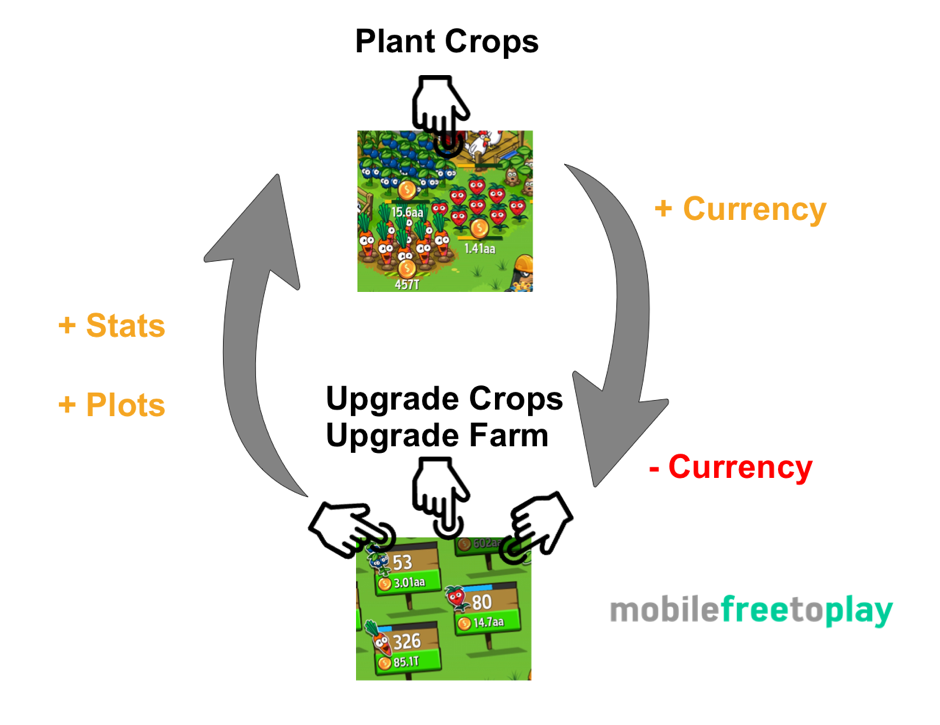
Increasing the rate of earning feels powerful
“Farm Away!” wraps the idle mechanic to planting and harvesting crops so that you can upgrade your crops and increase your rate of earning by buying more plots.
“Build Away!” uses a very similar system but you buy various building types and place them in blocks within a city.
Both games allow you to sacrifice all of your crops or blocks in order to get seeds in “Farm Away!” or keys in “Build Away!”. Investing into seeds or keys provide global growth bonus’ to help your future farms or cities.
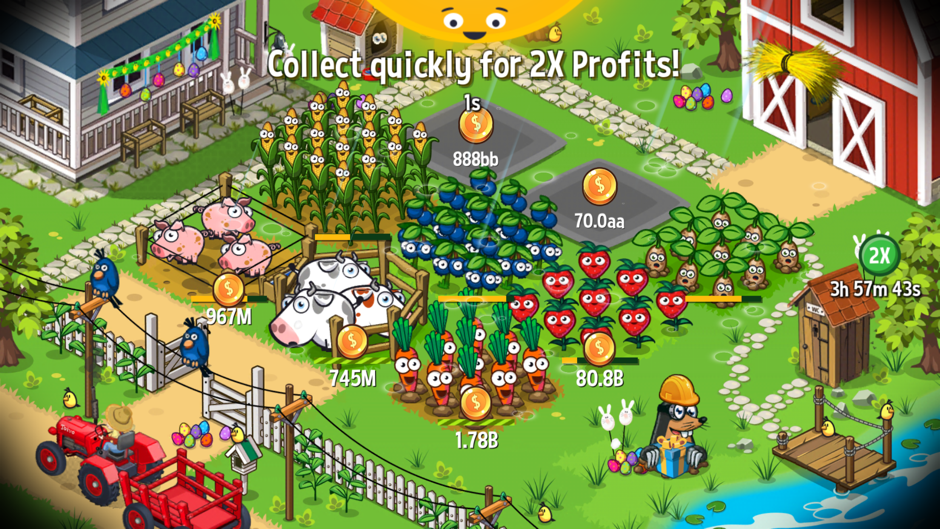
Video Ads: Opt-in + Attractive Rewards
Nobody wants to watch a video ad. So if you’re going drive a full video ad view you need to make sure it doesn’t feel forced (it’s opt-in) and players feel they are getting a benefit from it.
If you think of watching a video ad as a transaction of time (30 seconds) it will help you to design systems that respect the player’s choice. Just as buying an in-app purchase is asking people to sacrifice money to gain progress, here you are asking players to sacrifice their time to watch an advert. Asking players to do this not always possible or preferable, you might be sat on a busy train or having a romantic catch up with your girlfriend. Playing mobile games while having a romantic catch-up with your girlfriend is not advisable or you may find your romantic catch-ups become few and far between!
Therefore, allowing users to opt-in to view your video enables them to choose a time and place to sacrifice their time. People will very quickly learn which features of your game are powered by video ads. The clarity of the trade enables people to opt-in when they will get the most value for themselves. Clearly labelling the reward at the point where you choose to watch helps here. Enabling scheduling and power-ups that each work for different amounts of time enables a player to chose the most efficient trade for them at that moment in time. Having a breadth of options that caters for these needs leads to many more opportunities to view a video. More opportunities give a higher chance that any one of these might convert to a video view.
Making a video ad watch opt-in allows for scheduling, but making the reward feel positive and special will lead to higher conversions. Well designed rewards are those than enhance a player’s experience. For example, a boost to currencies the player would normally receive, increased speed to reward or a dramatic / exciting feature that isn’t normally available. As with in-app purchases, a strong sense of value makes watching the video feel worth it.
Rewards from video ads don’t only need to come from giving away currency or increasing the rate of currency gained. People appreciate novel experiences, limited offers or a chance at a grand prize.
FuturePlay uses 4 different strategies that each create a positive experience for their users. Remember as we discussed in the mobile video ads value chain increasing the number of views per DAU will lead to greater payouts in the end. So from a game design perspective building systems that can support 2-8 views in a single session rather than the classic 1 or 2 can have huge increases in monetisation.
1. Scarcity and Growing Value (Daily Double!)
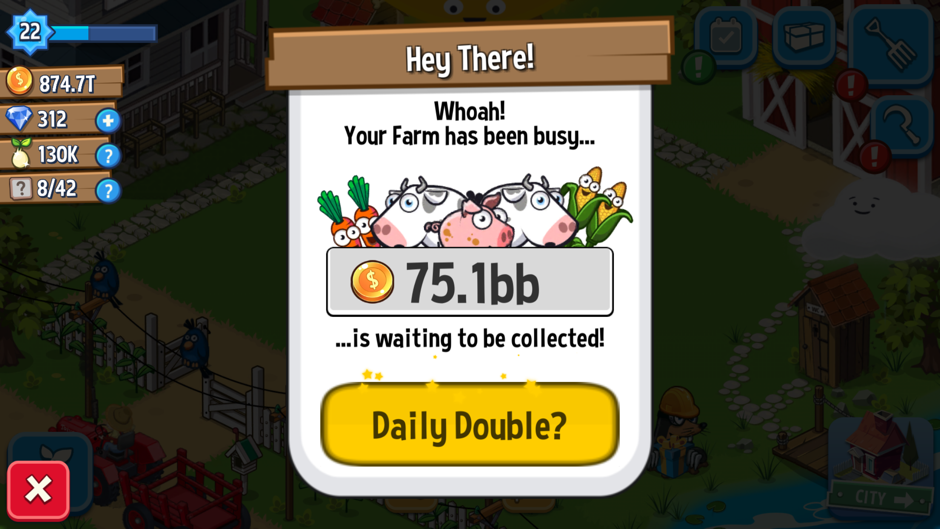
The strongest and most efficient video ad mechanic is the daily double. It offers to double the income you earned whilst away. Although very relevant to Clicker games as currency generation forms the core loop, a similar offer could be used in simulation games (currency doubling) or arcade (energy doubling) to give a highly valuable rewarding upgrade for the upcoming session. This has some very strong drivers:
- Obvious value that grows with time
- Presenting on appStart means everyone sees it and has the opportunity to opt-in
- Time limited availability which creates urge to take the deal now
The daily double effectively monetizes because it is high value (2x) and that starting value grows with time (seconds away from the game). Therefore, however long it has been, this bonus doubles it! 2X feels very rewarding for clickers and as a retention mechanic you get a larger boost no matter when you last logged, making your start feeling great!
Presenting a forced pop-up on appStart before the game begins, increases the % of your DAU which is likely to opt-in. People can only convert (earn you money) to an offer if they see it. People won’t feel bad if the opportunity is opt-in and valuable. As with all free to play designs you know your players are fickle, most players won’t even come back after a single day. Therefore forcing a high value, time-limited opportunity to kick start their game when they come back has the highest chance of conversion. For the view-to-play model to be successful you need to bump your average views per dau to 2-4. The way to do this is to be quite forceful. appStart provides the highest number of opportunities because it’s the first thing people will see.
The daily double is only presented once per session. By creating a scarcity in availability, people perceive the offer at a higher value even if the actual reward might be smaller. Putting people on the spot leads to more conversions. There are a number of psychology articles that talk about the effects of scarcity and it’s been used in marketing since the early 1970’s.
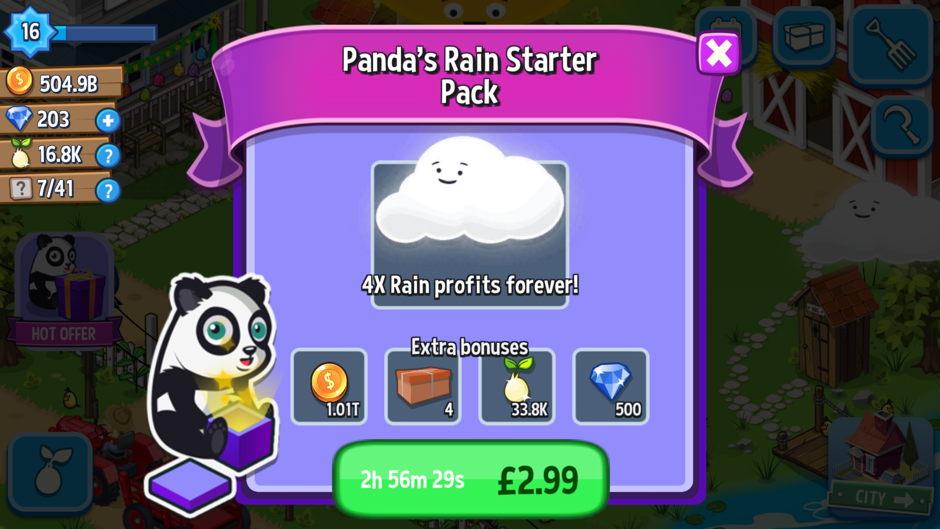
Any offer which is time or availability limited can create higher conversions due to a sense of urgency for players. To be effective the offer system should be presented to users multiple times across multiple sessions teaching people of its scarce nature. The more someone recognises a scarce item, the more likely they will be to convert when they see it. A good cadence for offers like this depends on the value of the reward. Once per session (Daily Double) has high cadence, low monetary value. A starter pack or time limited purchase (new players only) has high value, time limited. A special offer tied to an event or big update has high value and is availability limited can help to convert non-spenders into spenders. Video ad’s work best at the higher cadence lower value trades, whereas IAP works better at high value limited offers such as starter packs.
By creating a scarcity in availability, people perceive the offer at a higher value
2. Value over time (Session Doubler)

Clicker games benefit by being able to vary the rate of earning easily as their core loop supports a huge amount of depth.
By creating a large (2X or 4X) growth for an extended point of time the sessions themselves feel faster and progress feels quicker. This is quite like a feeling of increasing the flow of time (simulation) or even slowing down game-time in an arcade runner where a player’s game is made more comfortable. This form of trade adds value to your session, rather than short and sharp currency bonus’ that are quickly used up.
In other genres, it can be hard to create a similarly powerful video view because you need to keep a tighter grip over currency inflation. You should therefore consider speeding up an aspect of your core loop that encourages more play or more comfortable play of the core loop. For instance in a Base, Battle and Build (BBB) game, such as Clash of Clans, you might opt to increase the training speed of units by 2x by watching a video ad. This encourages more gameplay but doesn’t break your economy, it increases the number of battles played which positively reinforces the core loop.
If you have an RPG or adventure game then you might improve drop rates for 4h after watching a video ad encouraging people to continue to play longer sessions in order to maximise the benefit of the ad. Using video ads to strengthen the number of times a core loop is performed helps reinforce the positive moments and maximise the efficiency of a player’s time, creating a win-win scenario.
3. Short and Sharp Powerup (Instant Gratitude)

People run into situations where they need a little bit of help to achieve a gameplay goal. Creating a novel and fun power up that provides a short but sharp economic boost to help them reach a goal in that session. Futureplay turns this relatively simple power-up into a moment of joy for the player by encouraging them to interact intensely with the core action of harvesting in FarmAway! or collecting income from buildings in BuildAway! 20 seconds feels natural and a user can further increase the value by swiping as quick as possible to get an even bigger bonus.
Positive actions encourage a player to engage
Power-ups like this work by creating large environment changes such as increased animations, novel buildings or rare characters. The aim should always be to leave the user with a positive feeling. Some users may even watch a video ad in order to play the 20s mini-game. Think of a feature that fits your theme and allows people to play intensely for a short period of time, this might be doubling attack speed of a unit or increasing the power/size of in-game power ups in a match3. Think about ways you can trigger an exciting and special moment in your game that is unique but powerful to users.
4. Content Unlock or 1 More Life – (Unique Ability)
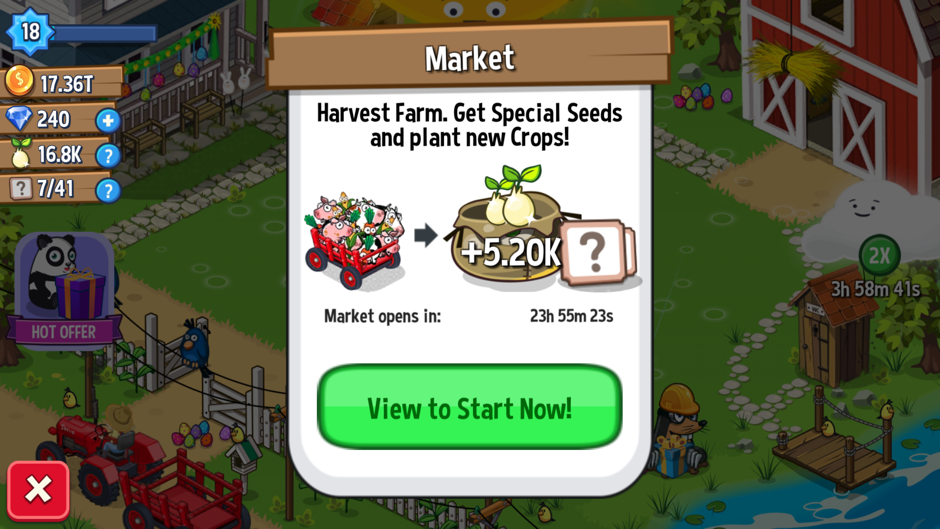
Certain features within your game might be critical to a player’s progress or score. In clicker games sacrificing your progress for global power ups is core to reusing the loop. Futureplay created a great and simple 24h blocker to prevent instant sacrifice. Players can skip this wait by watching yet another video ad. Patience is a virtue, but enabling players to gratify themselves instantly increases your views per DAU. Endless runners and frustration games use this very effectively to help people continue their progress in an attempt to get the highest score for a single run.
Unique abilities or instant gratification work so long as they are opt-in and don’t break your core game loop. Every game is different but by creating options and presenting them at different points allows people to choose when to feel clever.
Stack and Extend Video Views
The 4 different methods of watching a video are all unique but tied to positive actions that help a player to progress in their game. By providing 4 different features to watch a video, Futureplay has maximised the opportunities for players to watch a single video. In order to really boost their views per DAU, they have made more positive and valuable reasons to watch more than once.
- Every video views bonus stacks. So if the Session Doubler and Instant Gratitude feature are used together and effect 2×4 = 8x growth for a short period of time.
- Extending the period of certain bonus’ can occur by watching more than one video, this helps players to schedule their time in the game.
Effectively providing players with more opportunities to engage with video content around a feature will increase your views per DAU. Stacking of video views works well as long as you have a robust economy, be very careful that too many trades for currency or in-game growth don’t break late game systems in the game. When in doubt block players from too much stacking or extends. 2 or 3 stacks is enough for any single session. In this way, you can be sure that players need to keep coming back day after day and engaging with your game over a longer period of time.
At Slush in 2015 Futureplay revealed the Launch DAU and ARPU for FarmAway! Launch numbers and a staggering $0.09 ARPU during the launch window. Although they might not have maintained their high ARPU, it still shows what is possible for games that use the view-to-play model.
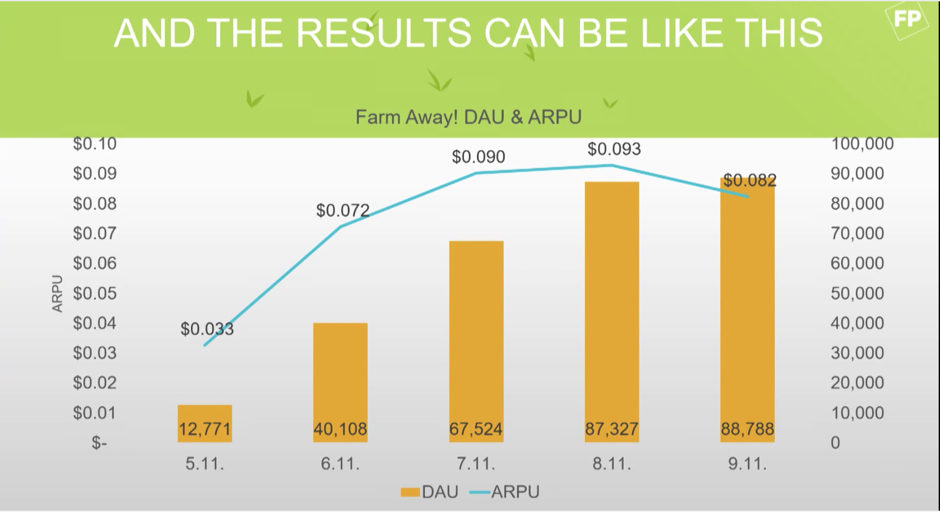
Watch the full video of View to Play by Futureplay at Slush 2015 – https://www.youtube.com/watch?v=TE6mF6VCxHA
Conclusion
View-to-play monetisation is now large enough to support gameplay mechanics that don’t work well with an IAP model. The biggest mistake companies make when trying to integrate the model is not providing enough opportunities for players to watch. Each of these opportunities should provide a positive experience either through value or interaction with the mechanics. High-value trades lead to a greater conversion of videos, but be careful that your economy is robust enough to handle this. When looking at your analytics make sure to track the video views per DAU in order to create features that lead to higher views. As the name itself makes clear View-to-Play requires views to generate revenue, use this to guide your development. View-to-Play is not applicable for all genres, but for some, it will be more lucrative than in-app purchases. Be sure to stick to the four guiding principles of view to play and track your video views in your analytics accurately. View-to-Play is here to stay and gives you more options to create financially successful games outside of the standard Match3, BBB or RPG mechanics.
Deconstructing Nimblebit Bit City
The latest release from Nimblebit features the Bitizens and this time they’ve used an idle/clicker/tapper crossed with a city builder in their new release of Bit City (iOS / Android). I’ve been a long time fan of the Nimblebit team, started by the brothers Dave and Ian Marsh back in 2007 but expanded to a number of other key staff. My personal favourite game of theirs was Tiny Tower, but I’ve also played and churned out from most of their newest releases. Pocket Frogs deserves a design mention as it still has one of the best collection/rarity mechanics of any game that I’ve played on mobile. Nimblebit specialises in creating a collecting or simulation experience around common everyday objects.
Bit City’s core mechanic is an endless economic growth game and the aim of the game is to progress through the 8 increasingly sprawling cities to generate the most income per second.
Clickers in General
The clicker or idle genre is one of the more recent but extremely popular free to play mechanics that we’ve seen on mobile. There are some great reasons why the mechanic itself has been present in many large successes such as Adventure Capitalist, Tap Titans or Egg Inc. At it’s core, the loop for a clicker is very simplistic. You’re trying to improve your rate of earning, in order to buy items to increase your rate of earning.
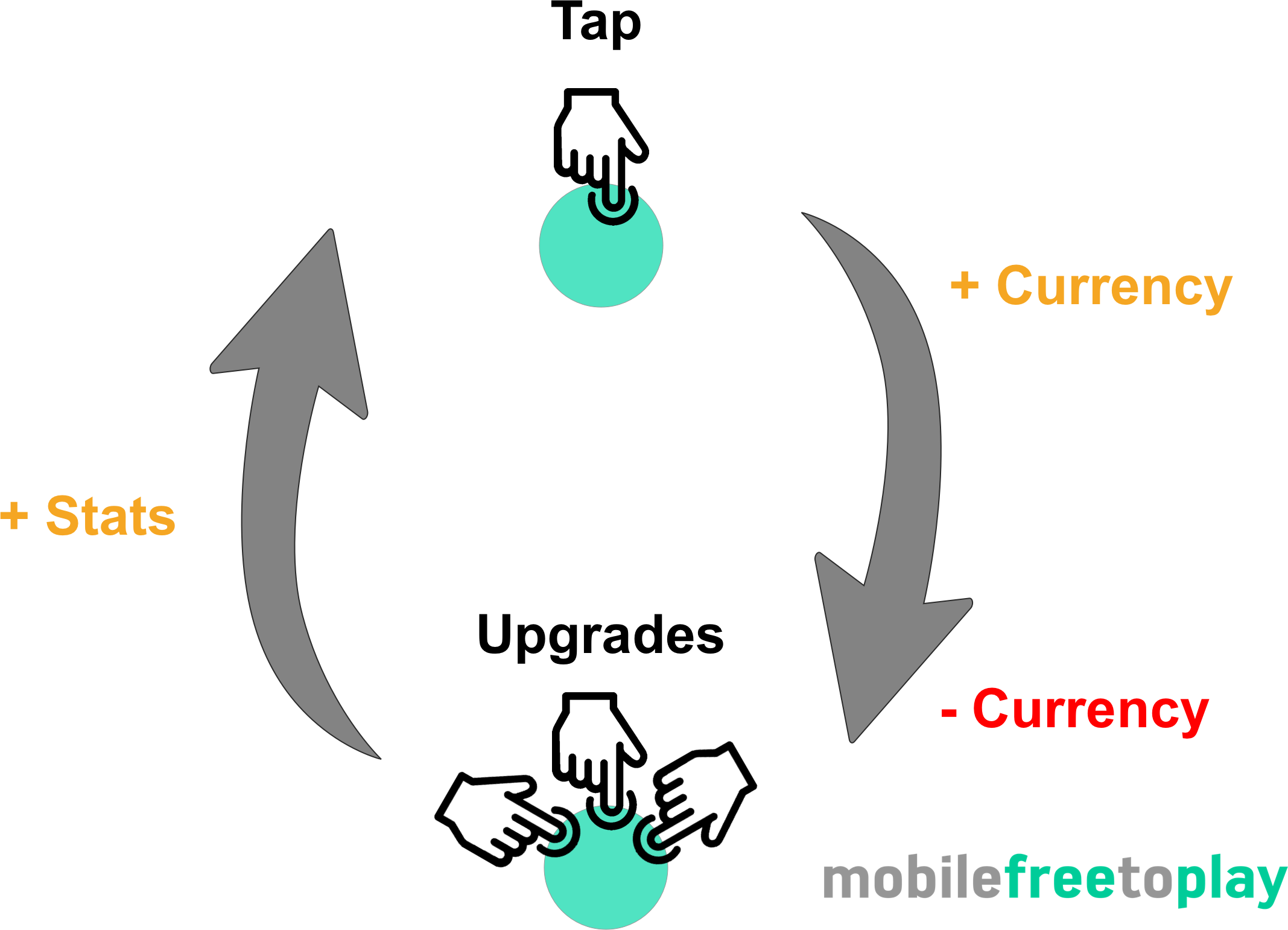
The simplicity of the core loop is both a blessing and a hindrance. The fact that everything you do in the game contributes to making you better at what you do (earning currency) feels very rewarding.
Every action is a positive action.
The hindrance comes when you eventually find the core interaction (tapping as fast as you can) repetitive and boring. In some clicker games, this can happen very fast. So, as a game designer, you eventually shift the player’s motivation from tapping to something that will last much longer. The clicker game genre eventually shifts into a strategy of choosing what to upgrade next. In Tap Titans 2 a player is strategically shifted from upgrading characters to gathering gear, pets or items. All of these have random drops and XP to give much more strategic depth. Upgrading anything feels good, but timing and choice matter.
No one can be expected to be active in a game forever which is where the idle aspect of most clickers come in. While you’re away your game is playing itself, constantly growing your earnings. That way when you come back, a stockpile of cash for you to quickly spend and improve to feel powerful. This happens every time you come back, whether it’s 10 minutes or 10 hours, the size of the stack changes but the feeling of reward stays the same.
The genre itself appeals to a certain type of gamer. Those obsessed with finding the most efficient and time-effective way to improve their progress (in the form of earning rate). Sometimes referred to as min/maxers finding 1-2% efficiency in upgrade choice is rewarding as you are progressing. Yet even the casual player feels good, you’re constantly making progress but at a lower rate. If you’re more interested in story and context then you will often not feel as excited about idle games. It is a game for fans of stats and numbers.
Bit City – Context provides content
Idle games began on the web with titles such as Cookie Clicker or Cow Clicker released around 2012-2014. 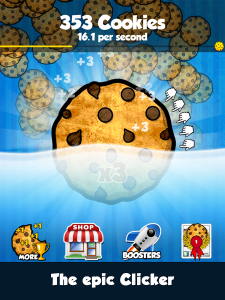 These games were incredibly simple. They drew huge numbers of returning users every day as the objective of “having the highest number” is so clear and powerful for players.
These games were incredibly simple. They drew huge numbers of returning users every day as the objective of “having the highest number” is so clear and powerful for players.
In more recent times games such as Adventure Capitalist, Tap Titans, Farm Away, Make it Rain have re-skinned the mechanic and given a context to the clicking. Context helps with design decisions as you immediately add more depth. Depth provides you with content and that content can better mask the simple stat progression. Player’s decide their goal is to “build the greatest city” rather than to “get the highest number” and this creates a better sales pitch if and when they tell their friends about your game. Context helps you design and it helps you sell, use it to your advantage and don’t neglect it by slapping it on at the end of development.
Bit City provides much more context to the clicking experience by using a city and it’s buildings to provide more visual substance and reference to the core loop. The City Context is a good one, used in multiple genres it’s easy to reference, has great depth and is applicable to people from all countries. Bit City uses this to great effect, but adding Building Zones, Cars, Planes, City Hall and Windmills each contributing to your currency earning.
Clicking = Building

The core mechanic of tapping furiously on the screen has been removed in favour of the idea of building. One must purchase and classify lots so that buildings of specific type are built. Buildings then fill each lot and the large Build button upgrades and refreshes the building on each lot for a small increase in coins per second earning power. The upgrading of buildings is endless and rather than getting stuck in a content farm black hole, the buildings are upgraded at random. Every upgrade levels up the block and each subsequent upgrade adds 1 second to the total time required to build the next block, leading in the later game to upgrades take minutes. Choice of which block to upgrade is removed from the player through randomisation and the player is taught very quickly that every upgrade is beneficial.
This is a very strong mechanic for a number of reasons:
- Thematically it makes sense. Your city changes with time and you can position blocks in certain areas to make your city look beautiful
- You may also lock in place any buildings you particularly like allowing the creatives build beautiful masterpieces of a modern renaissance!
- Choice paralysis is removed because you don’t need to choose what to upgrade and all upgrades are beneficial.
- Build timers slow down sessions giving people incentive to leave.
As a pacing mechanic, it continues to engage at all stages of the game. This is often one area that other clickers loose me on as in the mid-late game, I simply stop clicking…
City Planning
Simplicity and clarity are always key design decisions for mobile game developers. People spend a few minutes at a time with your game and so everything needs to be clear and make sense in an instant. The choices available to a player in Bit City always relate to upgrades. The most profitable upgrade you can do is buying a new building for your city as each building provides a larger base earning rate. A really nice design feature is the idea of city zoning. There are 3 zones, Residential, Industrial and Commercial. Within this feature is a lot of shallow depth, that is there are a very large number of options and possibilities but as a player, the way they affect the game is incredibly minor. They do not affect the core in any way, they simply provide a route to micro-optimisation, reinforcing the fun of clickers.
Each building zone is balanced by providing a 10% bonus or 10% deficit depending on the overall % of zones, this promotes people to build in an ordered manner. At certain times you may want to opt for larger investments in certain zones because both the Mission system and the City Bonus system provide bonus’ specifically based on type of building built. This is a good use of shallow depth again. Most people would not obsess over the minutiae of which building to build, but to really get the most optimisation at each minute of gameplay it might be valuable to invest in specific zones at specific times.
Missions with increasing reward
Another clever design decision is to reward ever increasing premium currency (Bux) by completing missions. Missions usually revolve around building, improving or owning some upgrade or building.
There is only one mission available at a time and they seem to be structured to appear in a specific order. Rather than having a small payout with lots of quick missions to teach people the mechanics, Nimblebit have used missions to give players a longer term goal. The cleverest of these is the ownership of 2 of the same building types i.e (2 Baseball Fields).
Mission systems are one of the classic mid-term progression systems. They provide a steadying hand and a focus for players when options of what to do open up. The best mission systems are usually curated or at least missions are grouped and then provided based on XP level.
The Premium Currency (Bux) are gifted in 10 bux increasing increments. This is risky, as it becomes a significant source of Bux in the mid game. I think the progression is a nice touch but the size of the progression is too high, it would have worked just as well say, 10,12,14 etc. At mission 13 I’m on 130 Bux which is equivalent to $0.13. Each mission can take an hour or more, but sometimes you might complete 2 or 3 in a few minutes. Although it might not seem a lot it lessens the requirement to spend. In the mid-game, it’s most profitable to focus on and perform the mission at hand. Balancing the rewards and spend of the premium currency is definitely one area that Bit City could improve on.
Progress, Profits, Prestige
Modern clickers increase the gameplay depth over time in a number of ways. These usually either increase the speed of clicks (Faster), the value of a click (More) or automating the clicking process entirely (auto). Each of these upgrades has a clear and tangible benefit, they help you gain more currency quicker, give your players a choice: do you invest in yourself being active in the game, or invest in the time you’re inactive?
Each city comes with a set number of plots. 4 for a level 1 city, 8 for a level 2 city etc. As you build more buildings you start to max out your plots. As soon as you have maxed your plots a new city unlocks and you sacrifice all of your upgrades and buildings to start again. This creates a clear goal for gamers and eases gamers into the game via small cities. As you progress the cost of each new building starts to become prohibitively expensive which encourages you to want to sacrifice everything in order to prestige to obtain Keys which will speed up everything in your game for the entirety of your play time.

System diagram of Nimblebit Bit City
What’s very pleasing compared to other clicker games is that the speed of progress is managed by a multiple limiting factors. Limits by multiple sources feel elegant rather than a strong single limiting factor. First, the coins themselves slow progress as you can’t build enough buildings, then the plots limit progress on one city as you max them out and finally the cities themselves become prohibitively expensive unless the global tap multiplier is improved by prestiging.
Prestige is very important as it adds ebbs and flows to an otherwise linear progression. Every time you do prestige you suddenly feel incredibly powerful as you race through early content, this is important as rather than having to create more complexity players are re-engaging with the game and reinforcing the simple systems of the game and progressing incredibly quickly. Bit City has created “mini- prestige’s” every time you upgrade to a new city once you have maxed out your plots. With every reset there is a sense of loss but also a sense of growth, getting your players used to this feeling helps them engage with the main Prestige mode.

In the mid to late game idle games, prestige currencies become the main goal in Bit City these are Keys. It’s very important to get the balance and the feel of Keys right. In Bit City, Keys feel underpowered as the quantity of keys provided when you prestige is too small. A user wants to feel progress at close to double the previous rate when they sacrifice all of their upgrades. Doubling up whilst keeping a logarithmic increase in the power curve of costs equates to half the time spent getting back to where you previously were. One you reach your old position the logarithmic power curve kicks back in and really winds back a player’s progress to a snail’s pace forcing them to prestige again.
A player chooses when to jump to the next prestige level and effectively picking at the right time can jump you onto a much more powerful curve. Great game design in this area wouldn’t use perfect logarithmic numbers but would add some randomness and inconsistencies to make it a guessing game for the player to find out if they are maxed out at an inefficient area of the curve.

Time taken to reach a city in bit city. Prestige levels and number of hours are representative and not factually correct.
UI / UX
It’s not mentioned in mobile how important the user interface is for a game. Especially in these management style games with large amounts of details, getting information across clearly and concisely is a challenge on a small screen. Nimblebit do a number of great reinforcements.
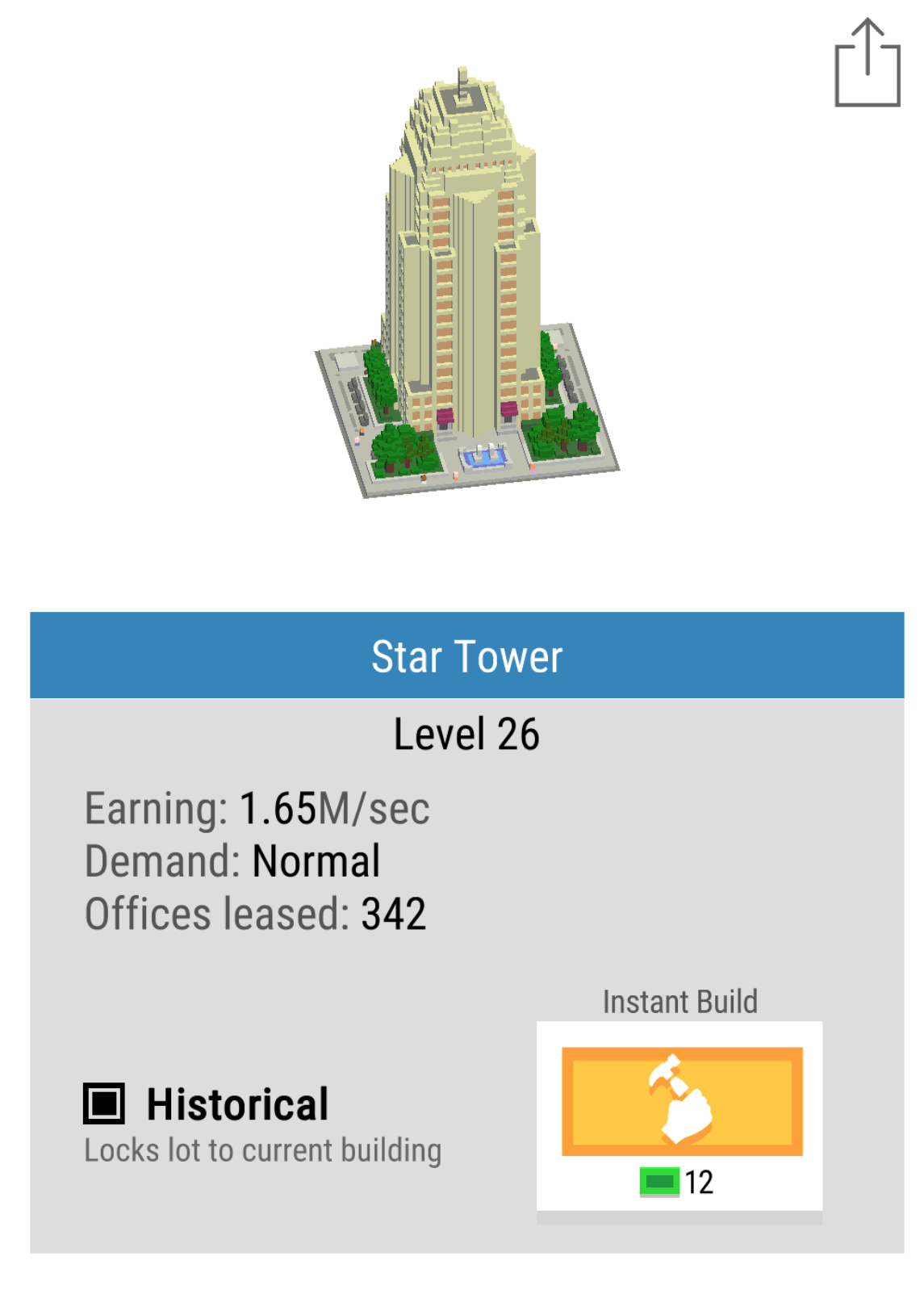
- Your key measure of progress is represented as a large central number of coins per second present on every screen.
- The build button (the button you click the most) is larger, more centralised and stands out from the rest.
- The subtle nuances of the game such as plot size, or building type are reiterated to you when you need the information, such as the quest system (large service)
- Before you make a large choice there is always a confirmation screen ensuring you are happy with your decision.
This attention to detail of the user’s journey removes frustration from the game. It allows you to choose where to focus your attention on to complete one or two of the tasks at a time and speed up your progress. A nice font and simple language make it enjoyable to read.
Monetising – Keep a tight grip
I’ve spent $10 so far in Bit City. For that, I got 10,000 bux. Bux are the only premium currency and are used to speedup progress, buy city upgrades that persist through prestige mode as well as unlocking certain famous buildings that provide enhanced bonus’. I feel that this was the point where the game design suffered.
- Bux are not a rare currency within the game. You can get 10s if not 100s of bux by completing missions or taping on vehicles that randomly drop bux, as a free player you can often buy a few persistent upgrades. When purchasing these upgrades there is no delight, magic or drama and as a player, all you see is your bux amount slowly draining. Purchasing the unlock of rare buildings was also much the same with a simple UI transition from locked to unlocked within the building card screen.
- No early conversion purchase. The Builder in Clash of Clans or World Multipliers in Adventure Capitalist, which immediately are the best bang for your bux! *pun intended…
- Gauging the value of upgrades is difficult. For instance, Market Gains for 1000+ bux increases your Bank Savings rate by 1%. This feels minor but would have a huge effect on the earning power itself. Rather than so clearly affecting such a powerful rate, investing in 20% cheaper bank upgrades would have had a similar effect to the player but would be immediately noticeable.
- No sense of mystery or delight when spending bux at any point. All bux are spent with a simple click and a UI change.
- No random drops. With it’s huge array of buildings creating a clear building rarity scale and then having a random drop element would make every bux much more exciting to spend. Random rewards have spikes of joy, rather than a focussed
I suspect the number of people purchasing bux will be low, simply because the number given out in-game is very high and people can immediately get a sense of what it would be like to have 1000s of them by spending a few hundred that they got for free. Games with great conversion rates keep the pressure on players to want to spend by constantly showing the value of having premium currency to progress. Bit City treats bux too loosely and as such the pressure to get my wallet out is low.
Video Ads – Double Time
I suspect that the game’s primary monetization route would be video ads. There is currently only one method to engage with a video ad through the opt-in button called “Double Time”. The value proposition here is strong, for a short period of time, double everything. Directly doubling the speed of progression is the best feeling for a player because it directly contributes to that core loop. Things that feel great in-game are strongest when they contribute to your progression directly. Clickers, by their very nature, are all about progress and so the reward is clear and easy to feel.
Unlocks happen more regularly I can build more buildings and progress shows a real gain. The upgrade itself is time limited to 10 minutes but with bux can be upgraded to 15 or more minutes. This again is a clever gamble as by getting people to potentially invest in an IAP they then encourage more video views, which if you remember is a key KPI for increasing monetization from video ads.
The major issue here is that there are not more ways to engage with video to improve those views per DAU that lead to more revenue. The 10-minute bonus is strong, but what about a 4h increase in the Bank Savings rate? Watch a video ad to upgrade a building directly would provide so many more places that a user could click the Watch button, increasing its adoption. The classic Double Up bonus for all returning players could be run once every 24 hours in order to highly incentivize at least one valuable video view per day. There is huge scope for expanding video ads integration.
Conclusion – Great Core, Monetization need Tightening
Bit City is a great example of expanding clicker mechanics into new genres. City Building and Clickers make a great match because of the depth in buildings and environment that are available to the team. Nimblebit have done a really good job of pacing the game across multiple cities causing you to have clear evolutions in your progress as well as allowing you to prestige at any time, making it your own decision. The type of upgrades and the thematic choice of upgrades fit nicely, all contributing to a busy and bustling city experience. The UI and UX of the game itself is also neat, simple and clear making playing the game an enjoyable experience.
The game’s biggest weakness will be its monetization. It’s very loose usage of Bux as a reward currency and the fact that players can only interact with video once per session without enough cues from the UI. The value of that video view is high so it should see good usage, but providing your most engaged and active players with more ways to watch would see many more views per DAU.
The games a great addition for the Bitizens and well worth a play!
Understanding the value chain for Mobile Video Ads
Video ad revenue now accounts for a large proportion of most casual free to play mobile games. Companies like Hipster Whale, Futureplay and the publisher Ketchapp have built business models focussed on rewarded video ads. This shows many of the similarities of the shift from premium to freemium. As an indie developer it’s relatively simple to drop a video ad into your game, but do you understand where the money comes from? In this piece we breakdown how the flow of money gets from the advertiser to your bank account.
Disclaimer: I have no affiliation and do not work for any of the partners mentioned, this guide is meant as a reference to understand where value resides and what motivates the companies involved.
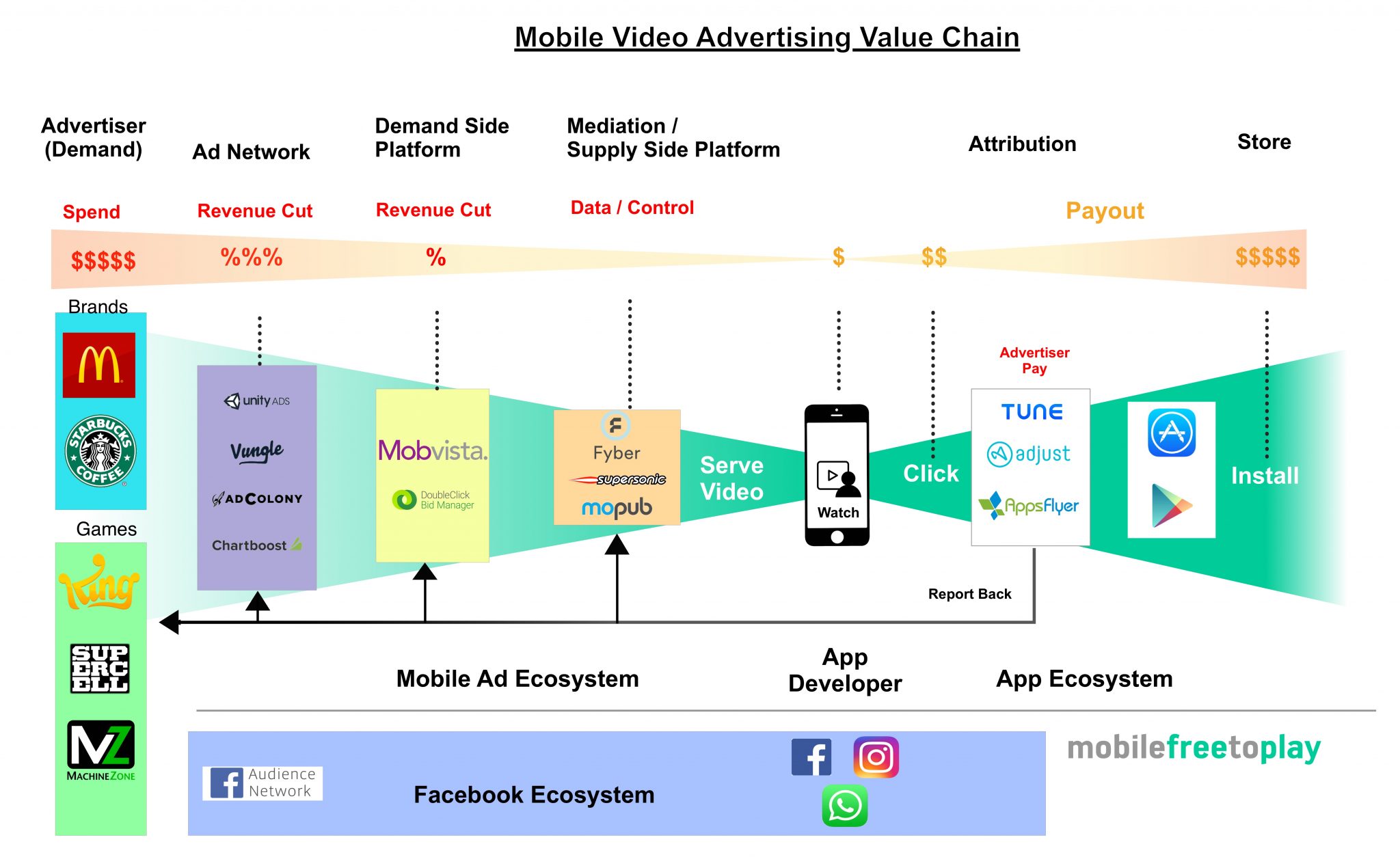
Making Money with Mobile Video Ads
Put simply, you use video ads to earn money and you earn money because advertisers pay to show videos to your players that drive installs of their app. As a rule of thumb the more videos you show the more money you will earn. With that in mind, your intention as a developer should be to increase the view count of videos shown to your users if you want to earn more money.
However, every view does not always equate to cash in the bank. The reason for this is that as an advertiser you want to pay for valuable actions. In the world of mobile, that ultimately means an install of an app. Developers only make money from the players who ultimately watch the full ad, click, then install the app. Every view should give you the best chance that a user will complete the video and are there more likely to install.
Your core KPI to maximising revenue is completed views per daily active user.
As you are unable to control a player’s behaviour after they have watched a video, you should focus on what you can control, the display and timing of the video. Within your games, your core KPI to maximising revenue is completed views per daily active user. Any number above 1 would be considered reasonable and over 4 would be considered very good! So set yourself the challenge of finding out what your current completed views per DAU is, then try to improve it.
Debunking the Myths of Mobile Video Ads
Most of the literature around video ads is unsurprisingly written by ad networks themselves. In each case, they have a mission to encourage the uptake of ads and are likely to involve selection bias to draw more positive conclusions. On the flipside, game developers who believe that video ads break experiences, ruin gameplay and alienate users might want to change their opinion.
Myth 1 – Video Ads Decrease Retention
Yaniv Nizan gave an interesting report on match 3 games showed decreases in D1 retention of around 0.5% but increases in revenue of over 89% for android or 278% for iOS. In this case, the negligible loss in retention is worthwhile when compared to the revenue earned. In my experience I’ve not seen vast changes in retention due to video ads as fundamentally retention is driven by your ability to bring players back to the game and adverts don’t promote or dissuade players from starting up your app. When video ads are placed in areas where a user opts in to watch and a cooldown timer is used to limit viewing, the rewards and bonus associated with the video can even draw players to come back in order to watch more videos for the rewards!
Myth 2 – Video Ads Lower Engagement
Fuse Powered (a mediation company) analysed 6 million players to show that the 9% of users that watched a video ad were 6X more likely to make a purchase. Again this statistic may be misleading as the 9% of users who watched a video are very likely to be your most engaged users. Video views tend to aggregate at the top end of your player base as they value your in-game currency the highest. Rather than any video ad lowering engagement directly, the cohorts that watch on average remain more engaged in games in general. Don’t make the mistake that the ad itself, led to the engagement. Engagement is created by the desire for the valuable currency to spend in your game. Giving players an opportunity to progress with premium currency without buying an IAP is a strong incentive to engage and keep playing.
Don’t make the mistake that the ad itself, led to the engagement.
Myth 3 – Video Ads Decrease In-App Purchase Revenue
If you analyse the top grossing chart then many of the top grossing free games will not run rewarded video advertising. This might be considered a missed opportunity as video ads have been shown to improve ARPDAU, but in the case of a top grossing game losing highly valuable users to your competition is a bad long term strategy.
That said, there are many games that are top grossing and do have in-app-purchases and rewarded video. It’s a choice that you as a developer will need to gauge via your own data, typically you might look for:
- If your 90 day LTV of your players is under $1 then you should be looking to increase earnings via video ads.
- If you have a very large cohort (1 million+ MAU) of players that are actively engaged then you can increase earnings via video ads.
- If your overall conversion rate from Player → Payer is below 1% then video ads will allow you to leverage the 99% of non-payers.
If the opposite of these statements is true for your game then consider reading the monetisation articles on improving ARPU in the Free to Play Bible. If you have the ability to either A/B test or remote configs then a common technique is to stop showing video ads to your payers or to only switch on video ad monetisation after a period of non-paying days.
The Mobile Video Ads Value Chain
Advertisers (demand)
 Within the industry, there are many different names for the clients on this side of the value chain: demand, publishers, brands, but I like to use “advertisers” as these are the people who pay for the adverts. Within the mobile video ad space, there are actually a relatively low number of advertisers that make up the majority of spend on the platforms. This is because running effective large campaigns can cost many $100,000+ per day. Overall the number of advertisers on mobile and their total spend continue to grow each year and show no sign of slowing.
Within the industry, there are many different names for the clients on this side of the value chain: demand, publishers, brands, but I like to use “advertisers” as these are the people who pay for the adverts. Within the mobile video ad space, there are actually a relatively low number of advertisers that make up the majority of spend on the platforms. This is because running effective large campaigns can cost many $100,000+ per day. Overall the number of advertisers on mobile and their total spend continue to grow each year and show no sign of slowing.
It’s important to understand that an advertiser will only run a campaign (a video ad on an advertising network) if they are going to generate more value than the cost of the campaign. In simple terms, they usually need to equate an ad campaign to an LTV > CPI to be able to continue to run the ads.
One of the reasons rewarded video ads have become so popular is their ability to actually drive views. Every video watched is opt-in from the player who has chosen to spend the next 30 seconds to watch whatever is presented to them in order to receive a valuable reward. This works well for both gamers and advertisers as people want to watch the video at that point in time. This is why rewarded video has been one of the areas where advertisers have continued to spend big.
Video Ad Networks
Ad networks can get a bad rep… but they are good for one thing… they tend to throw lavish parties with lots of free drinks! 🎉

You may not like Ad guys, but they’re your best bet for driving revenue from high DAU – Low LTV games.
An ad network’s role is to talk to advertisers (i.e. Machine Zone) to run a campaign to promote apps across their network. Each campaign has different targeting (French/Dutch/German, Women, over 25) and objectives (Drive installs) and the network aims to optimise against achieving that objective. Every Ad Network has positives and negatives which can be hard to find out in advance. However, unlike the old days of print or tv advertising, a number of standard convention KPI’s that all networks provide. Comparing these numbers between networks is key to choosing which network is best for your game.
| Acronym |
eCPM |
CTR |
Fill Rate |
| Meaning |
Earnings per 1000 views shown |
Click-thru-rate |
Requests that receive a video. |
| Good Value (estimate) |
$12-20 – T1 Country
$5-10 – T2 Country |
1-5% |
>99% |
Ad networks can be private, where you receive content from a single source i.e Unity Ads or be a larger DSP (Demand Side Platforms) i.e Mobvista that aggregate lots of different ad campaigns from multiple sources.
Ad Networks tend to be very protective of their campaigns and run them exclusively on their own controlled SDKs. Demand side platforms usually allow the advertisers finer grain details of where they want to run their adverts, device, size, geo’s or even within specific apps (blacklist/whitelist). A reasonable list to check out for good ad networks from 2016 is on the Soomla site. If you’re just starting out and focussed on the US market then I would recommend Unity Ads, Applovin and AdColony as 3 networks to start with. Other smaller niche networks can work much better in other countries such as Yandex for the Russian Market. If your game starts to scale significantly, spend more time researching this field in particular.
How Do DSPs Work?
Demand Side Platforms (DSP’s) make it easier for an advertiser to buy across multiple, discrete inventory sources. The aggregate lots of different advertising channels into their single platform. DSP’s may strike a deal directly with a single large app developer for all of their views, or be working in partnership with an ad network to provide extra inventory at peak times. Due to their scale, often larger brands such as Nike or McDonlads would work with DSPs to reach the widest possible audience in the simplest way. With a single login and dashboard – running, reporting and optimising campaigns at large scales becomes much easier.
Facebook – The Biggest, Baddest Ad Network of Them All

The largest video ad network on mobile is Facebook. Unlike the other ad networks, Facebook handles all the infrastructure and tracking that is needed from the ad network to the store and even controls the display of the advertising in the apps themselves (Facebook / Instagram). This gives Facebook a huge advantage when attracting cash-rich advertisers to spend on their network as they know much more about the user and can present the user with a more relevant video. Facebook fiercely guards this data about their users and advertisers and platforms must abide by Facebook’s rules if they want to use the platform. This helps facebook maintain high-quality ads for its users.
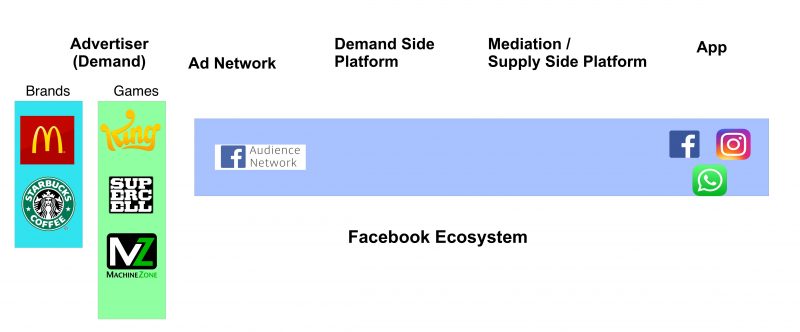
The total mobile ad spend of 2016 is estimated to be around $40 billion and Facebook has around 1.15 billion mobile users in 2016. This huge user base is also very loyal with 66% of users logging in daily to Facebook; a metric similar to having a very high retaining game. Facebook has created its own consolidated value chain and has simplified the experience of using it from both an advertising and user perspective.
Facebook also has a lot of personal metadata about you that you willingly provide, your, age, sex and location are key pieces of data, but every like, interaction and comment can be used to guess what type of person you are. All this information allows facebook to show more relevant ads to you that you are more likely to click on and install. Inevitably this is why facebook can command higher prices for similar advertising space.
Mediation
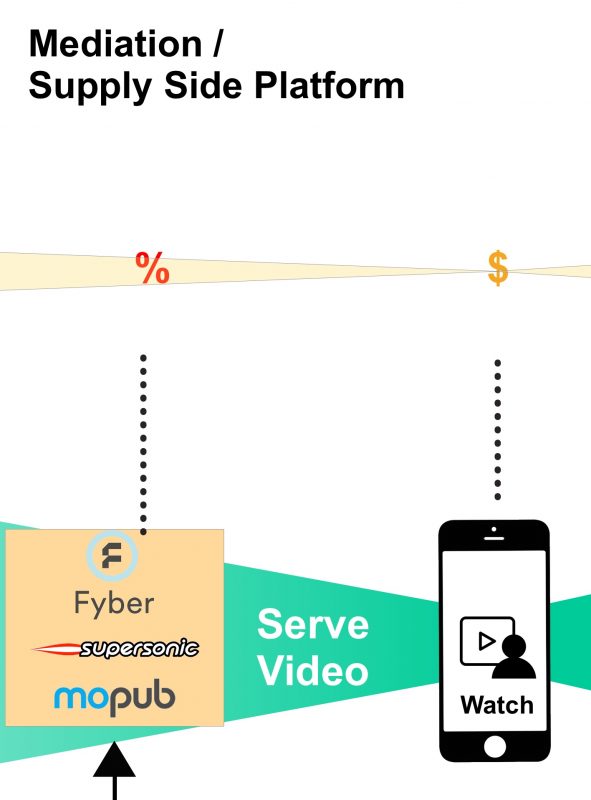 Mediation companies (Fyber / Supersonic) and Supply Side platforms (SSP’s) we’re setup to help developers to optimise the delivery of advertising within their app. Their role is to switch seamlessly between ad networks in order to maximise your fill rate (the number of videos shown per request made for a video) and to show the highest paying network to your audience depending on their location or other pieces of data they have collected.
Mediation companies (Fyber / Supersonic) and Supply Side platforms (SSP’s) we’re setup to help developers to optimise the delivery of advertising within their app. Their role is to switch seamlessly between ad networks in order to maximise your fill rate (the number of videos shown per request made for a video) and to show the highest paying network to your audience depending on their location or other pieces of data they have collected.
The real benefit to mediation is that as a developer you can remotely control and change your ad viewing, ad caps, network priorities and revenue reporting in one place. This benefit can save you many hours of laborious report checking and analysis to find out exactly which networks have been profitable for your game. There is no single best network or best setup: track, analyse and review on a weekly or monthly basis and adjust on what you see.
There is no single best network or best setup: track, analyse and review on a weekly or monthly basis
Mediation is usually free for developers. Although this noble endeavour of making a developer more money, most independent mediators have now been acquired or aggregated into ad networks themselves: Fyber by RNTS Media for $190 million and Supersonic by IronSource for an undisclosed fee. This allows a mediator to force a percentage of the views to their ad network of choice for which they might be reimbursed.
As a game developer adding a mediator requires a small amount of work, but it often provides you with a much more stable platform to track, analyse and review your ad networks. For that reason, I would always recommend either using a mediator or mediating SDKs yourself using a simple remote config to switch between ad network providers.
Game Developer (Supply)

You sit in the middle of the value chain. Creators of hit, fun experiences that encourage gamers to play and come back every day. Without a hit game, there would be very few people watching any of the videos.
A game developer’s primary goal is and should always be, make a fun experience that people want to come back and play again. Never lose sight of this when creating a game. Advertising slots around your experience and should not detract from it. Players are not against watching videos in order to earn valuable virtual currency. However, if there are intrusive or large un-skippable video at awkward periods within the app you are going to frustrate your user base. For videos to be effective and enjoyable you should always make them opt-in to view and allow a gamer to choose when and where to watch. This will increase engagement and video completes.
You have the audience, fundamentally that is where the value lies
You’re also the decision maker to which SDKs will be integrated. There is a lot of value to the ad companies if they can have their SDK in your game. If you have a very large audience (1 million+ DAU) then you may be able to negotiate better rates with partners. Put your business hat on and be shrewd! You have the audience, fundamentally that is where the value lies. The data of how your users play, who your users are and whether they have paid or not are all pieces of information that are highly lucrative to all parties across the value chain.
Attribution
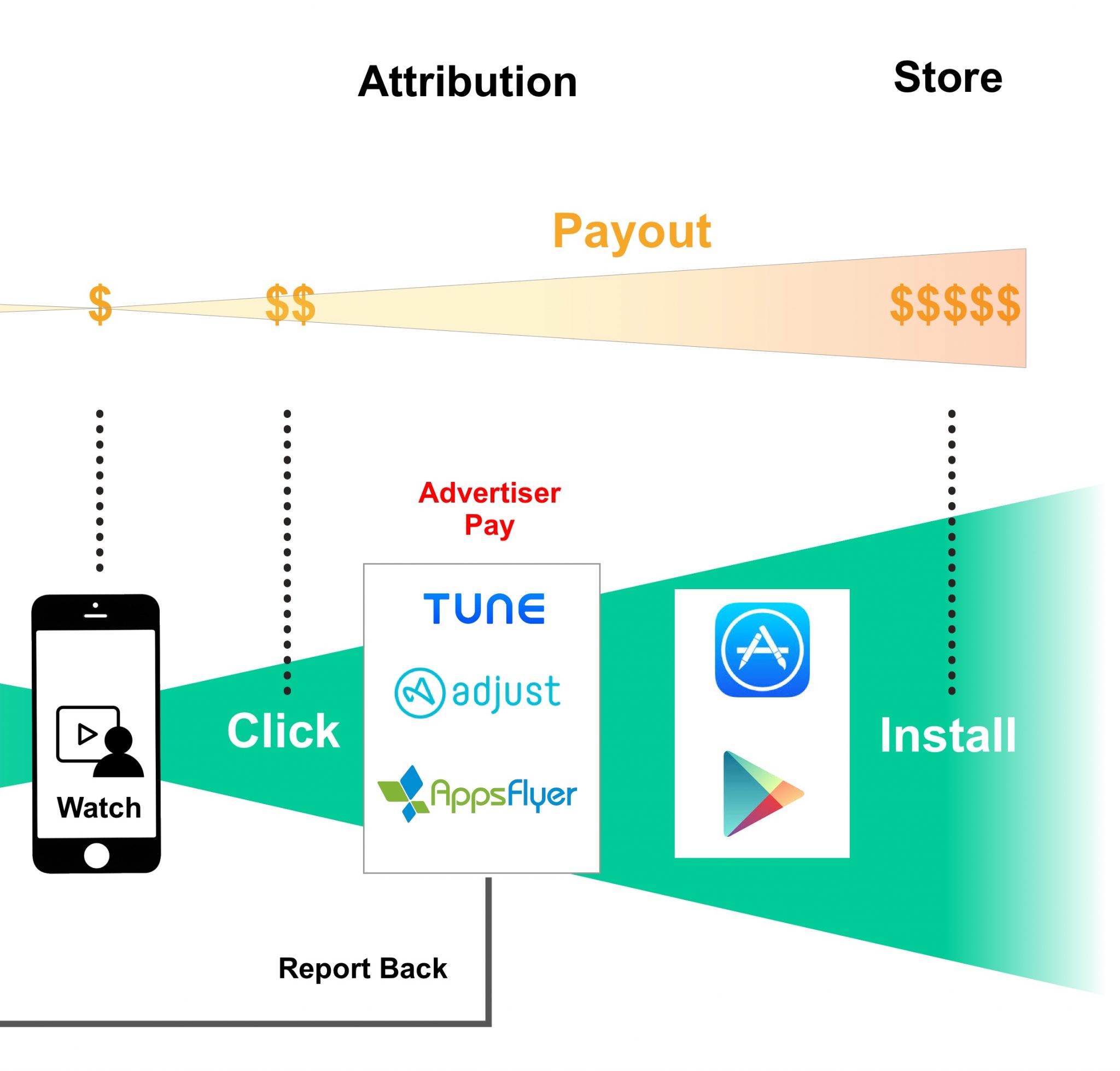 Attribution sits after the video has been shown to the user. These companies are responsible for tracking the install and reporting back to the Networks who was responsible for driving this user to install the game. They act as a 3rd party intermediary on the whole video ad value chain. They are also one of the only parties in the value chain that are able to charge directly for their service. Usually, they make money by charging advertisers a cost per install tracked and so add a layer of cost to any ad campaign.
Attribution sits after the video has been shown to the user. These companies are responsible for tracking the install and reporting back to the Networks who was responsible for driving this user to install the game. They act as a 3rd party intermediary on the whole video ad value chain. They are also one of the only parties in the value chain that are able to charge directly for their service. Usually, they make money by charging advertisers a cost per install tracked and so add a layer of cost to any ad campaign.
Fraud prevention is becoming more and more important as the rate of fraud is increasing with an estimation that almost 34% of all traffic is susceptible to fraud. Fraudulent traffic, such as fake installs or click-stuffing damages the whole ecosystem as it results in bad traffic. Advertisers see less value and so stop spending money on the network. Attribution attempts to pick up on these fraudulent users quickly and ban them from the ecosystem.
Third party intermediary ad networks rely on attribution to determine which ad network served the ad that led to the last click before install. This makes a big difference if you are a large publisher who is running tens if not hundreds of campaigns on multiple sources because you only want to pay once for the install. There are a large number of legal hoops that an attribution network jumps though to ensure trust for its clicks. As a smaller developer, you may not need to add in attribution if you are running a small ad campaign on a single source. Facebook and Google and many of the other video ad networks provide valid attribution for free if you advertise on their networks and you use their SDKs.
As mobile video spend grows, fraud becomes more lucrative and this part of the value chain will become more and more important for advertisers.
Stores (Apple and Google)
All installs occur via Apple and Google and so all clicks created by videos will end with a visit to their respective stores. As neither Apple nor Google gives much information about what users do on the stores it was the black box of the mobile world. Since 2015 both stores have started to give some data back to game developers in the form of store analytics, but they don’t provide this data to ad partners directly and so the post-click journey of a user is not visible and therefore hard to optimise for.
The stores add direct value to the whole chain as installs of games drive new users who may purchase in-app purchases or create brand loyalty and awareness by apps rising up the charts. The fact that there are only two major stores left in mobile, show the power they both wield and staying on the right side of both Apple and Google is a must for any mobile developer.
Conclusion – What should I do now?
With a clearer idea of the value chain in the mobile ad space, you should understand what value companies provide and who to talk to at different stages of development. Try to take some action in your current project to improve ad implementation:
Small Game (10k MAU) – If you are not using a mediation company, find one. Get 2-3 ad networks that you know and trust and add video ads to your shop for free gems. Focus on observing the number of views and as the game grows, get better at event tracking how your users interact with video. Use this to learn what a baseline is for video views in your game.
Mid Game (100k MAU) – Now it’s about increasing video views and increasing your revenue from each view. Work with your product team to think of more innovative placements to access the video, spend time making it fit within your theme, if you can A/B test ideas do this to increase completed views per DAU. In unison set out to talk to more varied ad networks who work in different Geos, Audiences or game types, you could start making more money in non-western countries etc. Try to get 4-5 networks in.
Large Game (1M MAU+) – You are likely to have a reasonable setup here and a person who is more dedicated on marketing or revenue generation. You may be working with 5-10 networks now, avoid SDK bloat. Can you work directly with a DSP? Can you cut a direct deal with an ad network? Can you approach an advertiser or a game company directly?
If video ads start to make over 50% of your revenue, can you create new features to increase views? Remember to continually compare networks revenue and tracking numbers. Work on a bi-weekly rotation to promote or demote networks within your app based on performance in particular GEOs.
In the future, I’ll be writing more article on video ads, in particular how to optimise in-game placement and get more completed views per DAU. Stay tuned!










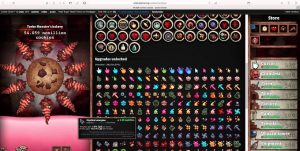
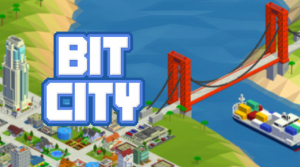

 These games were incredibly simple. They drew huge numbers of returning users every day as the objective of “having the highest number” is so clear and powerful for players.
These games were incredibly simple. They drew huge numbers of returning users every day as the objective of “having the highest number” is so clear and powerful for players.









 Within the industry, there are many different names for the clients on this side of the value chain: demand, publishers, brands, but I like to use “advertisers” as these are the people who pay for the adverts. Within the mobile video ad space, there are actually a relatively low number of advertisers that make up the majority of spend on the platforms. This is because running effective large campaigns can cost many $100,000+ per day. Overall the number of advertisers on mobile and their total spend continue to grow each year and show no sign of slowing.
Within the industry, there are many different names for the clients on this side of the value chain: demand, publishers, brands, but I like to use “advertisers” as these are the people who pay for the adverts. Within the mobile video ad space, there are actually a relatively low number of advertisers that make up the majority of spend on the platforms. This is because running effective large campaigns can cost many $100,000+ per day. Overall the number of advertisers on mobile and their total spend continue to grow each year and show no sign of slowing.



 Mediation companies (
Mediation companies (
 Attribution sits after the video has been shown to the user. These companies are responsible for tracking the install and reporting back to the Networks who was responsible for driving this user to install the game. They act as a 3rd party intermediary on the whole video ad value chain. They are also one of the only parties in the value chain that are able to charge directly for their service. Usually, they make money by charging advertisers a cost per install tracked and so add a layer of cost to any ad campaign.
Attribution sits after the video has been shown to the user. These companies are responsible for tracking the install and reporting back to the Networks who was responsible for driving this user to install the game. They act as a 3rd party intermediary on the whole video ad value chain. They are also one of the only parties in the value chain that are able to charge directly for their service. Usually, they make money by charging advertisers a cost per install tracked and so add a layer of cost to any ad campaign.